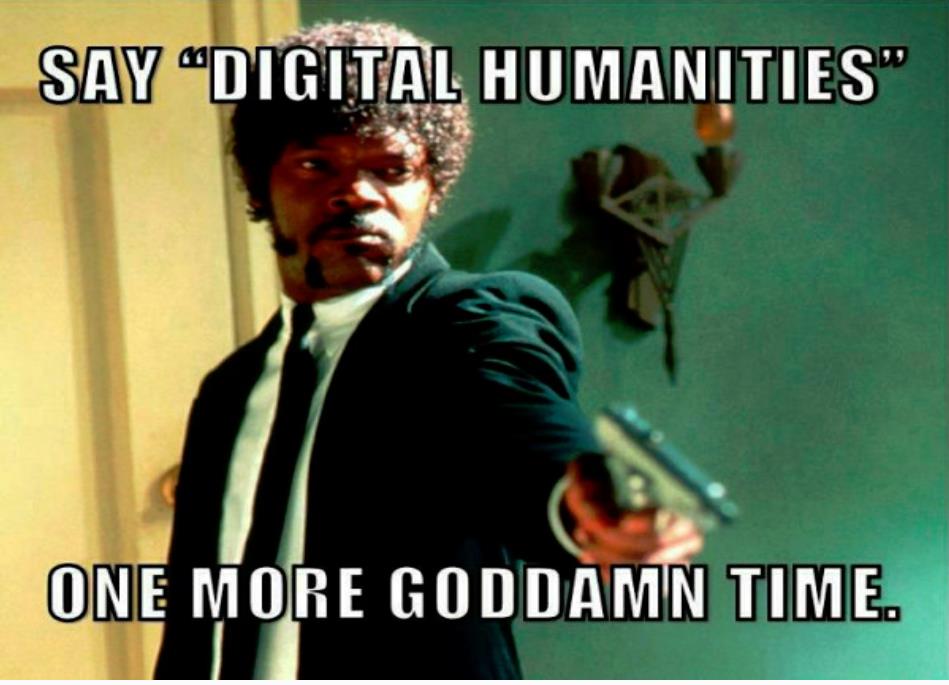
The above meme featuring Samuel L. Jackson has circulated amongst students of the University of Amsterdam for the past few years. It is credited to Frank Ridgeway (2012) and sums up feelings of frustration when confronted with yet another lecture teaching the gospel of new, digital research methods and the joys of Big Data. More established historians have also engaged in a debate about digital humanities and although they may have not used quite the same words, article titles such as ‘Veins filled with the diluted sap of rationality: a critical reply’ (Fickers, 2013) speak volumes about the spirited tone of their academic conversation. Concerns are also raised about a possibly narrowing focus on research questions that can be answered using computational methods, rather then adapting software to the questions.
Furthermore, the finite amount of financial funding for humanities-related research and the ever growing portion of it that is allocated towards digital projects leads to uneasiness and a loss of career opportunities for those preferring traditional methods. Considering that a simple google search using the terms ‘digital humanities’+ debate* yields about 1.860.000 hits, this is clearly a controversial topic. However, the very existence of the above digital-born meme and its quick distribution via social media also signals the inevitability of adding digital tools to the historian’s arsenal. This will become an even more pressing issue in the future, since the record of our own time is becoming increasingly more digital then physical.
Debates on topics such as Big Data or the merits of close reading versus distant reading might be relatively new, but the underlying sentiment is not. Traces of it can already be seen in the nineteenth century with its focus on more ‘scientific’ methodologies, plus related concepts such as positivism and technological determinism. Take for instance the historian H.T. Buckle (1821-1862), who devoted a large portion of his life trying to write a never-finished, all-encompassing history of all civilizations in the world, starting with Britain. Buckle did not want to preserve. He wanted to predict, and thought that reading the 22.000 books he accumulated during his lifetime would give him that ability. In his own words: ‘When we perform an action, we perform it in consequence of some motive or motives… those motives are the results of some antecedents, and… therefore, if we were acquainted with the whole of the antecedents (…), we could with unerring certainty predict the whole of their immediate results.’
It is not difficult to imagine the glee Buckle would have felt knowing that at some point in the future, his modern counterparts would be able to search through thousands of documents at the same time, finding correlations in the blink of an eye. Yet such a wealth of information can also be overwhelming. How can you stay focused on your object of research when information is flowing in from all directions, but most of it is presented without context? It is not productive to dismiss technological advances just because they do not mesh with traditional research. New methodologies and concepts are always useful –although the degree varies-, even when applied to topics that have already been studied intensively.
In ‘Big Data for Dead People: Digital Readings and the Conundrums of Positivism’ (2013) Tim Hitchcock describes his experiences with rethinking traditional ways of doing research. Using the vast online archive of London’s Central Criminal Court, Old Bailey, he zooms in on a woman arrested for theft in 1871. He uses her case in order to show how a properly marked up and tagged person of interest can be tracked and traced through time like a human DHL parcel, barcode included. When combined with geographical tools like GIS, available photographs or portraits and social network visualizations, this makes the people of the past more tangible then ever before. Old Bailey is not the only archive that is accessible this way -or working towards it-, and the amount of searchable data is rapidly growing. This is especially the case when the help of volunteers is used for simple tasks such as georeferencing.
At the same time, this raises issues of privacy. Born into a lower social economic class and in her sixties, Sarah Durrant was most likely poor and not in a position to turn down any opportunity to improve her financial situation. Thus, she stole two banknotes in 1871. She received a two-year jail sentence and endured the fear and discomfort that comes with such an event. However, thanks to modern technology, one could argue that she is still publicly shamed for it almost a hundred and fifty years later. She has no unique personality traits; she is remembered as a thief. This lasting consequence of her petty crime is something she could not possibly predict in any way. Is it fair to let this be her only legacy, theoretically accessible for billions of people through google, for many years to come? When a historian tries to show the person behind a written text, does that person not also deserve to be treated as an actual person, dead or not?
Most historians -including myself- might have mixed feelings regarding the privacy issues of the subjects they study. But thinking about this can provide a starting point for discussions and a link to contemporary debates about privacy, Big Data, google and personal representation on social media like Facebook, which captures the Sarah’s of tomorrow in neat little data parcels. Contrary to what Buckle thought, the closer we are to knowing everything there is to know about human beings, the further away their true selves sometimes seem.
Linda van Exter, 14-09-2016